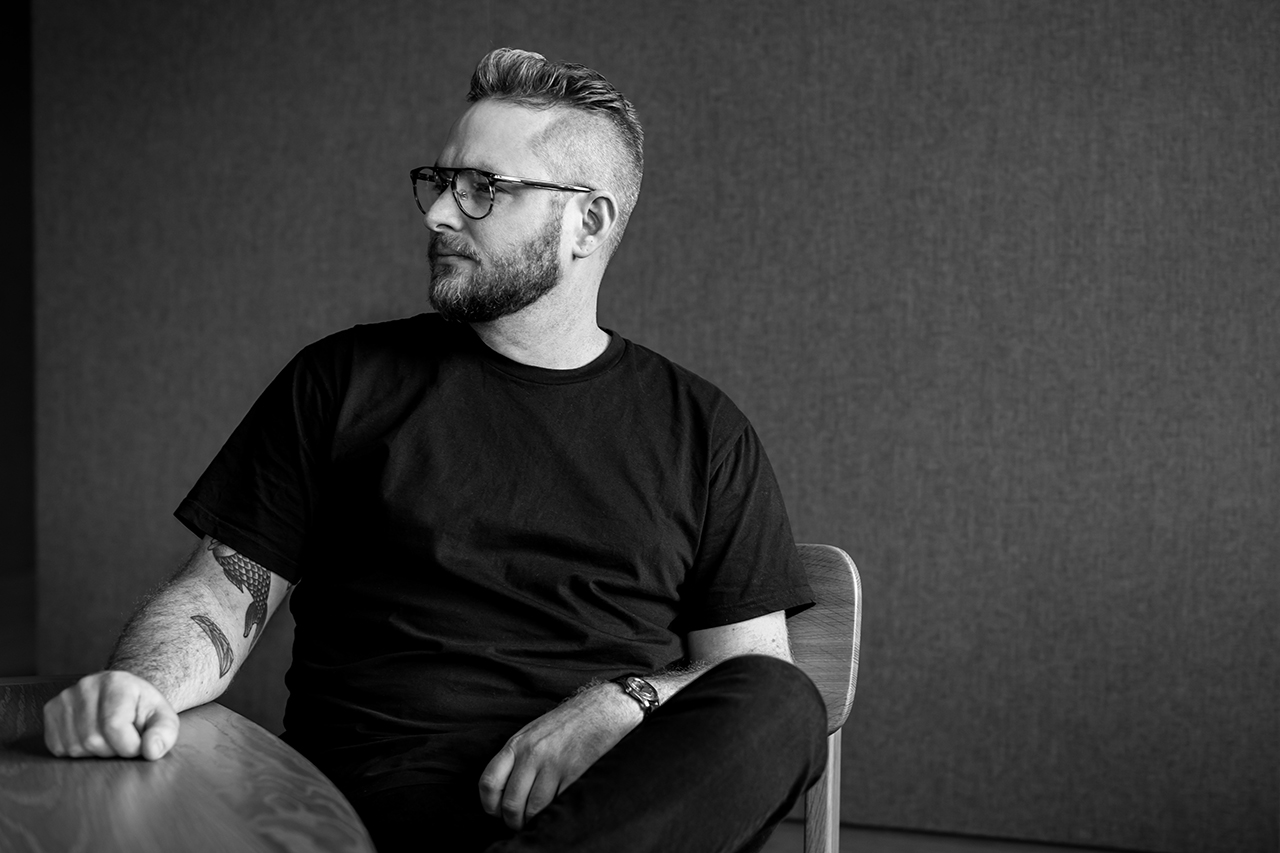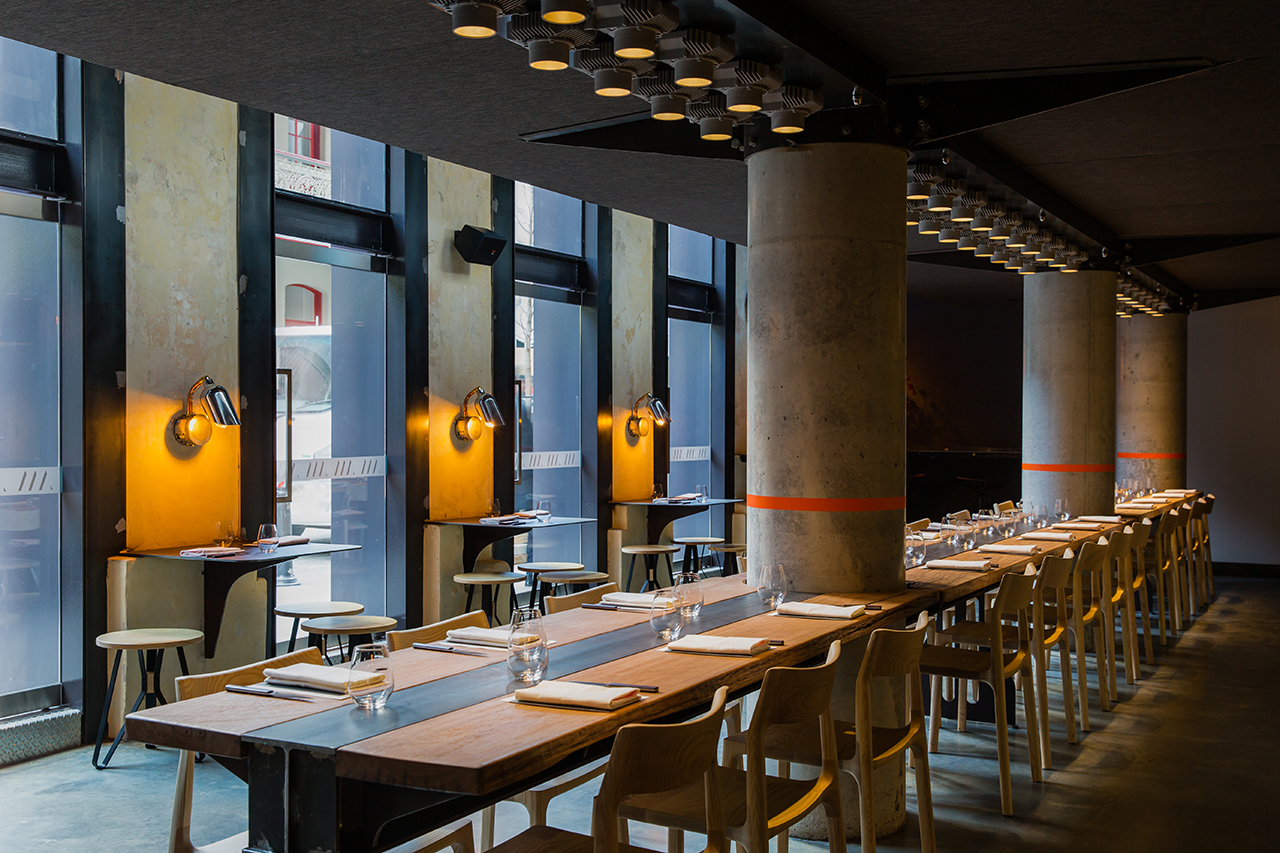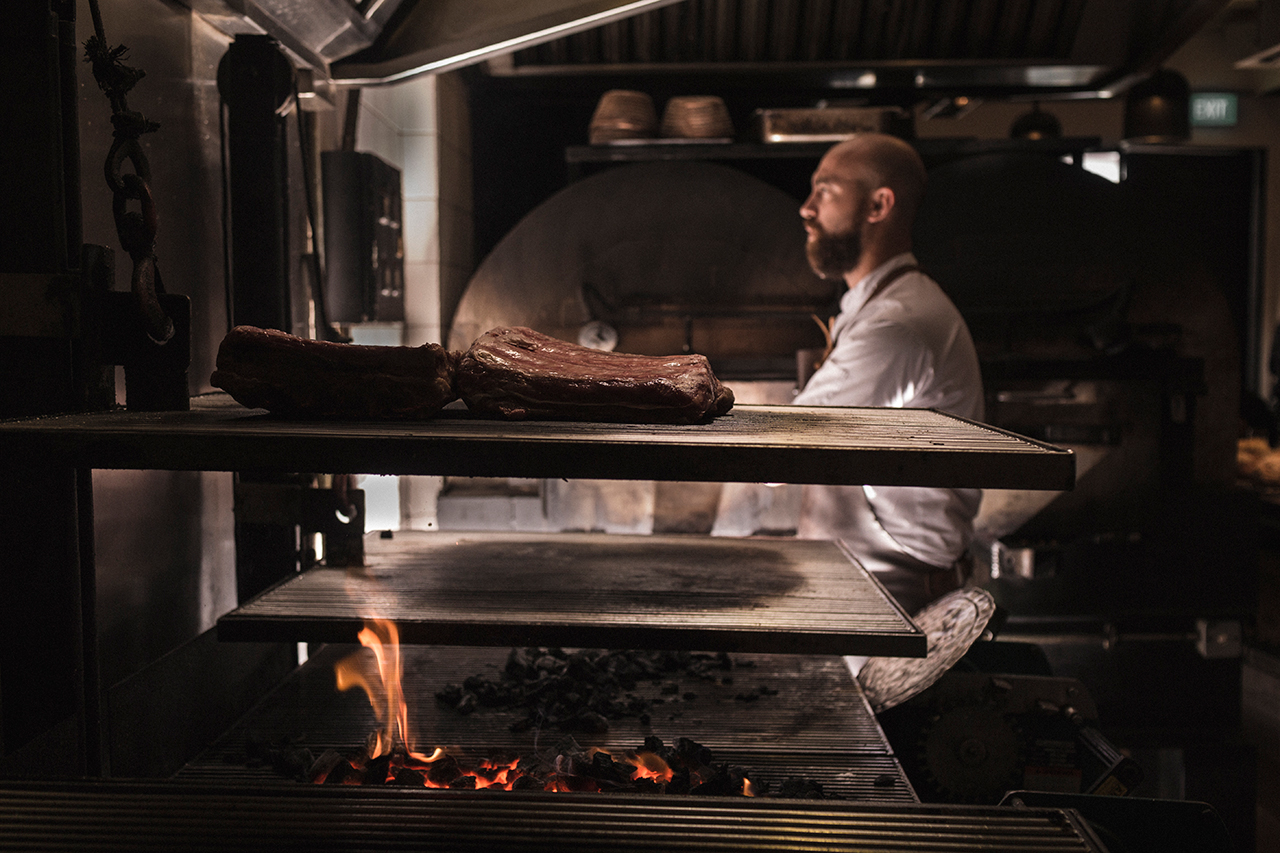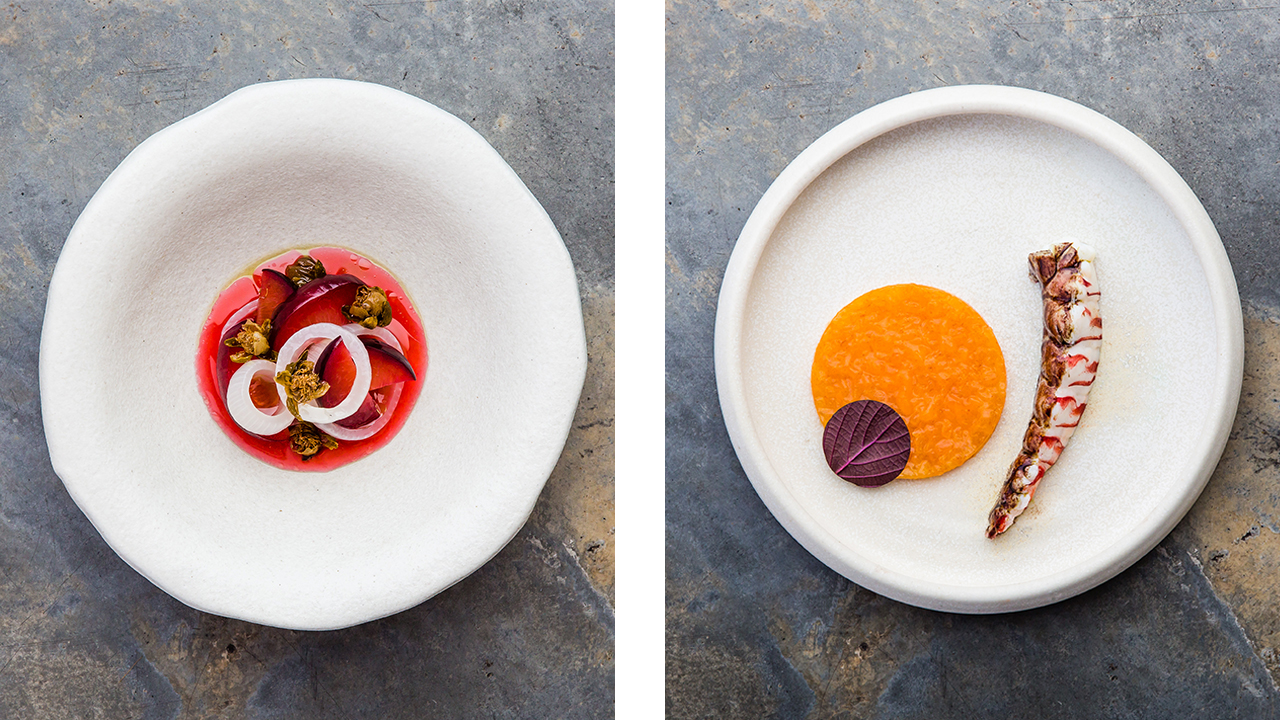News feed

It’s perhaps trite, though nonetheless true, to say that Automata runs like a well-oiled machine. During service, the galley kitchen – which opens onto a ground-floor dining room dominated by a reclaimed hardwood communal table bisected by a steel spine – is rarely pitched at anything higher than a polite stage whisper. Above, two rows of 50 new/old stock Ducati cylinder jugs, now in their second life as barrel down lights, illuminate plates of food that are anything but mechanical in their execution.
“In terms of our approach to the food, I try to be fairly free with what we do,” says Clayton Wells, the 35-year-old head chef of the restaurant, which is also the flagship dining enterprise adjoining The Old Clare Hotel in Sydney’s inner-city Chippendale precinct. “It’s very easy to take yourself too seriously. It’s very easy to believe the hype as well. Because we’re doing well, we’re cooking great food, we’ve got a great restaurant. We’ve got a beautiful staff. My whole front-of-house team has been here since day one. That’s incredible. And that’s not normal.”
In the midst of it all, striving to maintain that sense of normalcy, is Wells. At one point during service he can be seen inspecting a plate of deep orange Cape gooseberries, each one – sweet and small, like an uncanny hybrid of a pineapple crossed with a tomatillo – subject to the scrutiny of Wells and his bookish spectacles. At another interval, he stands perfectly still in the middle of the kitchen like the eye of a storm, his arms the only thing moving as he vigorously swivels the handle of a mop back and forth between his two hands. With the mop and bucket obscured by the stainless steel island that separates the two spaces, it appears almost as though he’s trying to achieve friction enough to light a spark and set the stovetops ablaze.

Wells’s star is already burning bright, of course. The recipient of a great deal of the many ‘hottest young chef’ accolades handed out in recent years, Wells is one of a growing class of young Australian chefs and restaurateurs not only delivering world-class food and dining experiences at home in Sydney, but working with a view to taking those very qualities that make his work exceptional to the world at large.
“What I set out to do [with Automata] and what we’ve done is very similar. I’m content with what we’ve got right now but I still want to continue to get better, of course. You always want to get better. But I don’t want to lose focus of what we do, because this is the heart and soul of this business. It’s about atmosphere, it’s about a great work environment, and it’s about producing excellent food without the bullshit. That’s really quite important to me.”
That each successive In-N-Out Burger pop-up of the last few years has been occasion enough to roll out a red carpet is proof positive that Australia’s bottomless gastronomic appetite has reached a fever pitch. Add to that the sell-out appearances of chefs such as Osteria Francescana’s Massimo Bottura and Eleven Madison Park’s Daniel Humm at the Sydney Opera House and Margaret Court Arena (considered the second-best and best restaurants in the world respectively, according to The World’s 50 Best Restaurant Awards) and the well-trod ‘rock star’ epithet that chefs are now accorded starts to seem a little less farfetched than it first sounded.
It was Melbourne, of course, that played host to the aforementioned World’s 50 Best awards in April this year, temporarily repositioning the city as the epicentre of the culinary universe. One year prior to that, the Sydney edition of Danish chef René Redzepi’s pop-up phenomenon Noma uprooted itself after a sell-out four-month residency that shone an impossibly bright light on Australia not only as a bounteous and untapped pantry teaming with incredible produce, but a far-flung culinary destination within its own right – one worth going the distance for.

“The world is truly becoming a smaller place due to the Internet and social media,” says Sam Christie, the Managing Director for four restaurants: Longrain, in both Sydney and Melbourne, The Apollo and Cho Cho San, also both in Sydney. In April last year, Christie and his business partner Jonathan Barthelmess opened the second iteration of their modern Greek restaurant The Apollo in the Ginza neighbourhood of Tokyo, Japan. In August, Christie opened a third branch of his Longrain restaurants in nearby Ebisu, “one of the great dining prefectures of Tokyo”. Christie says that the globalisation of food and dining, proliferated by social media, is “infiltrating and boosting the Japanese people’s already huge obsession and lust for food and wine”, which made the decision to open two new ventures there in the space of one year a natural fit. “The Japanese have really cottoned on to Australia’s sense of casual style and attention to detail in the past few years,” says Christie. “The healthy, fresh food thing that we take for granted here is a change to the traditional Japanese dining options.”
It’s a sentiment shared also by Marco Ambrosino, Enrico and Giovanni Paradiso, the three partners behind Sydney’s third-wave Italian institutions Fratelli Paradiso and 10 William Street. In a similar fashion to Christie and Barthelmess, they opened the second iteration of their Fratelli Paradiso restaurant in Tokyo’s Omotesando Hills shopping precinct in April of this year.
“The Australian dining scene is bringing real sensibility to dining – its approach has stripped back the layers: [it’s] approachable, seasonal, connected and relevant.” Not content to wait, both form part of a broader coterie of chefs and restaurateurs taking their singular vision for a new wave of Australian dining and cuisine – an entity as amorphous and open to interpretation as the term would suggest – to the world stage. Both parties made the transition to an international market with the assistance of the Transit Group, a cultural engineering firm with what Christie describes as a “sustained strategy to change the scene in Tokyo and throughout Japan”.
It was the Transit Group who have assisted in turning Bill Granger’s eponymous brand of beaming Sydney café culture into a global franchise with outposts in Tokyo, Kanagawa and Fukuoka, alongside those in London, Honolulu and Seoul. On a recent visit to Tokyo, I witnessed lines for the Omotesando branch of bill’s the likes of which I’ve never seen anywhere in the world, for anything at all – least of all ricotta hotcakes.

“Our proximity to Asia is easy on the travel”, agrees Wells, who’s also slated to open his maiden overseas venture, Blackwattle, in Singapore in September. “There’s so much opportunity there, a broader range of ingredients and the community as well is so into food and restaurants, just as we are here.
“That’s why it seemed right. We weren’t openly looking for something; I wasn’t looking for a site in Singapore by any means. It just happened. And that’s why it feels good. I thought that eventually I’d like to open a restaurant somewhere in Asia, that it would be wonderful, and it came around faster than expected.”
A relative lack of red tape and the foundations from the site’s recent past as another restaurant means that progress on Blackwattle has been, true to form, swift. Unlike Automata, whose opening coincided with that of The Old Clare and two additional restaurants and enjoyed a year-long germination process, Blackwattle has been the benefactor of fortuitous timing and fast decision-making in equal measure. “I think I learnt a lot in that time,” says Wells. “How to plan for things, and what’s important. My crockery that was made for Automata was made in Singapore and it’s all bespoke; it took nine months to get that. I knew that the second that I said yes to doing a restaurant in Singapore [that] we had to find some crockery because someone’s got to make it. If I didn’t have that experience, we’d be in trouble.”
Wells says his involvement in each restaurant extends beyond what’s eventually served on that crockery and into every conceivable facet of the experience: “the architecture and design of the restaurant. Choosing the furniture. The feel and look of the leather that might go on the chairs. The colour palette of the room and the branding. If it’s my restaurant then it’s exactly how I want it to be. It probably puts more pressure on myself, but at least I know that when we open it’s exactly how I want it to be.”
Where possible, Wells has tasked local artisans and architects with executing his vision in practical terms. He has enlisted the same ceramicist as before to create the restaurant’s crockery; another local studio, Mud Rock, will complete the remainder of the task. Singapore-based architect Akira Kita has been charged with the redesign of the split-level converted shop house. The brief was to strike a balance between “comfortable and moody, but a bit rock and roll as well”, similar to what Wells has achieved with Automata, where the tones of the dining room run the gamut from chrome to blond wood and concrete; or to hear the sound system tell it, from LCD Soundsystem to Radiohead, by way of Pearl Jam.

When Blackwattle opens its doors, Wells will find himself in a place familiar to many of his antecedents: at the helm of a now international restaurant group whose very nature means his attention must of necessity be divided along lines of time and place. “Making sure the mothership stays stable and consistent,” he says, “that’s still the number one thing […] that you’re not forgetting about what made us who we are.” Joeri Timmermans, who worked alongside Wells during his time at Momofuku Seiōbo and who came across for the opening of Automata, will head up the kitchen at Blackwattle; Sarah Knights, formerly of Quay, will take his place in Sydney. Wells will oversee both operations, the menus at which will continue to change consistently and seasonally. “I want Blackwattle to have the same DNA as Automata in the way that we do things, the style of food.”
While the mentality will remain the same, Wells will extend the restaurant’s opening hours to cater toward the city’s lunch trade and open what’s usually a set five-course degustation menu up to an à la carte option. It’s a predilection for consistency in spite of the variables of time and place, he says, that he picked up during three years spent working at Seiōbo, the Australian outpost of chef David Chang’s culinary empire – also his first outside the United States.
Wells, however, won’t be alone in Singapore. Sam Aisbett, former head chef at Quay, also opened Whitegrass in the same city in early 2016. It recently received its first Michelin star. At nearby Marina Bay Sands, a leviathan of a casino punctuated with world-class dining outlets, the first of David Thompson’s Long Chim eateries rubs shoulders with Tetsuya Wakuda’s Waku Ghin, which was recently adorned with a second Michelin star.
Dave Pynt, a good friend of Wells, opened modern Australian barbecue restaurant Burnt Endsin Singapore in 2013; last year it entered the World’s 50 Best Restaurants list at number 70, climbing this year to 53rd place. They share a business partner in Loh Lik Peng, the Singaporean hotelier, restaurateur behind the Unlisted Collection of 27 properties worldwide, including The Old Clare, which houses both Automata and Kensington Street Social. Wells met Peng in London in 2010 and the two have remained friends ever since. Together, they worked across the opening and eventual closure of Peng’s restaurant with the Portuguese chef Nuno Mendes, Viajante, in another of the hotelier’s properties, the Town Hall Hotel in East London’s Benthal Green.
Peng, it would appear, not only has a knack for transforming moribund industrial relics – albeit heritage-listed ones – into thriving boutique hotels with an adjacent food offering that’s equally as hard to turn down, but for fostering incredible young talents such as Wells and Pynt. The latter, in particular, has proven to be an invaluable source of “no bullshit” advice for Wells as he prepares to open his first restaurant abroad. As in any race toward the finish, there are few hurdles to be navigated – another way of life and a new language to be reckoned with; suppliers and competition to negotiate with; oceans to be crossed – that can’t be dwarfed by the perspective of someone who has traversed them before you.

More immediately, Blackwattle will keep good company. Amoy Street, at the edge of the city’s downtown and Chinatown precincts, is not dissimilar from Automata’s current postcode. Next door, the Swee Kee Fish Head Noodle House regularly attracts lines that snake down the street toward one of the city’s most popular hawker centres, where many woks makes light work of a lunchtime crowd desperately seeking plates agrodolce char kway teow and saccharine pulled milk tea; across the road, the 19th century Thian Hock Keng temple offers respite from the din; and at night, the street sings with the warm glow of its many cocktail bars. In the midst of it all will sit Blackwattle, an old shop-front unable to be missed with its three-storeys rendered baby blue, all white plantation shutters and Italianate moulding.
With each successive visit, Wells says he’s opening those doors more widely to the influence, the ingredients and flavour profile of the local cuisine. An encounter with a bowl of bak-kut-teh – pork ribs broiled in a piquant white pepper broth – triggered in Wells a desire to bring those elements home, as though he’s running a kind of culinary exchange program. “We made a mud crab dish with braised pumpkin seeds in a white pepper broth. I’m not copying it; it’s just one tiny element or flavour profile that we can develop something different on, which is exciting.”
Upstairs, a small cocktail bar and terrace will service the needs of those seeking respite from the city’s notoriously balmy evenings. Don’t hold your breath for a twist on a Singapore Sling, however. Wells wants to bring across a wine program with the same focus on diversity, affordability and, above all, distinction that makes the one at Automata such a remarkable to-drink list.
Though Wells has been cooking for what he estimates to be just over 16 years now, he says he never could have envisioned now having two restaurants – let alone two in separate countries – to his name. Though his is a resumé that proves formidable in its litany of names alone – Quay, Tetsuya’s, Seiōbo, Noma – Wells credits travel with broadening his repertoire as a cook. “It’s very easy to paint with the same colours if you never really leave one city,” he says. “That was a really, really important part of my career: stepping out into the unknown. It was a big eye-opener.”

It was while he was working at Tetsuya’s in 2009 that he decided to decamp to Copenhagen. At the same time, the wave of the Nordic food movement was beginning to crest, though Wells concedes that his decision to eschew the direct route to London’s Michelin-starred restaurants for the requisite two-year stint raised a few eyebrows. “I wanted to do something totally different and see a different part of the world. And that’s exactly where I went. And that blew my mind. That really did. It’s just crazy to think that you can walk through a forest and pick out your dinner. That really, really shook me up. That was probably the turning point for me, I think, just being shocked at the amount of things that are possible.”
Wells staged – a kind of culinary internship – at Noma for a couple of months. In that short period of time, he met Ben Greeno, who helmed operations at Momofuku Seiōbo since the restaurant first opened in 2011. They’d work alongside one another for three years on their return to Sydney, but not before Wells would circle back to London, where he’d have his fortuitous first meeting with Peng and Mendes at Viajante. Its name, fittingly enough, translates to ‘the traveller’. “It was an interesting restaurant, and I think it was probably a couple of years ahead of its time in London. It was a love it or hate it kind of restaurant.”
It was faith, ultimately, shared between Wells and Peng that would prove to be the more enduring aspect of that partnership. “He’s seen something in me to want to open a restaurant here. He believes in what we do, and me, which is amazing. I guess his thought behind it is, if you back a person and what they believe in and what they think is going to happen, and they put everything that they’ve got into that, then it’ll work. Or it should work.”
“I never opened [Automata] with the thought of what we were going to achieve,” Wells continues. “I just wanted to open a cool restaurant that served amazing food, but had a relaxed atmosphere. There’s definitely a shift worldwide toward that.” Time then to get into gear.
Tile image: Nikki To/Courtesy of Automata
Cover image: Courtesy of Burnt Ends










